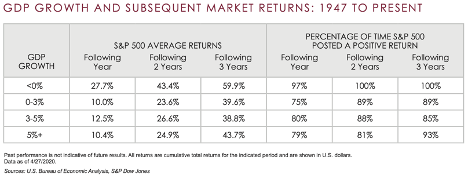15 May GDP Growth and the Stock Market
The Bureau of Economic Analysis, the official scorekeeper for US GDP, recently announced that real GDP for the US economy decreased at an annualized pace of 4.8% during the first quarter of 2020. As we all know, the second quarter is going to be far worse given that the Covid-19 crisis didn’t take hold in earnest until March. The current consensus among economists survey by the Wall Street Journal calls for GDP to decline at an annualized rate of 32% during the second quarter; some more pessimistic forecasters are anticipating a decline of great than 40%. Regardless of what the precise figure is, we are essentially a lock to see GDP down on a year-over-year basis as of the end of June. Perhaps counterintuitive to many, such an occurrence may actually be considered a good sign for stock market investors as negative prior-year GDP growth has actually historically been followed by comparatively strong future stock market performance.
The table below, from Renaissance Investment Management illustrates the relationship between past GDP growth and subsequent stock market returns. The table groups past GDP growth on a trailing four-quarters basis into buckets of negative growth, growth between 0-3%, growth between 3-5% and growth in excess of 5% and examines stock market returns over the subsequent 1, 2 and 3 years as well as the percentage of observations where positive returns were realized.

The data clearly demonstrate that stock market returns on average were actually higher over the following 1-, 2- and 3-year periods following a contraction in GDP than during any of the periods were past GDP growth had been positive. In addition, we can see that stock market returns were more likely to be positive after negative growth than they were following positive growth.
This data highlights two crucial aspects of markets for long-term investors: (a) markets are forward-looking and trade not on “good” or “bad” but rather, “better” or “worse,” and (b) mean reversion is powerful concept in investing as bad stretches for the economy and the stock market are often followed by comparatively strong ones.
Sources:
Renaissance Investment Management: “Market Update-GDP Growth and the Stock Market.” April 2020.
Important Disclosures
Kathmere Capital Management (Kathmere) is an investment adviser registered under the Investment Advisers Act of 1940. Registration as an investment adviser does not imply any level of skill or training. The information presented in the material is general in nature and is not designed to address your investment objectives, financial situation or particular needs. Prior to making any investment decision, you should assess, or seek advice from a professional regarding whether any particular transaction is relevant or appropriate to your individual circumstances. This material is not intended to replace the advice of a qualified tax advisor, attorney, or accountant. Consultation with the appropriate professional should be done before any financial commitments regarding the issues related to the situation are made.
The opinions expressed herein are those of Kathmere and may not actually come to pass. This information is current as of the date of this material and is subject to change at any time, based on market and other conditions. Although taken from reliable sources, Kathmere cannot guarantee the accuracy of the information received from third parties.
An index is a portfolio of specific securities, the performance of which is often used as a benchmark in judging the relative performance to certain asset classes. Index performance used throughout is intended to illustrate historical market trends and performance. Indexes are managed and do not incur investment management fees. An investor is unable to invest in an index. Their performance does not reflect the expenses associated with the management of an actual portfolio. No strategy assures success or protects against loss. There is no guarantee that a diversified portfolio will enhance overall returns or outperform a non-diversified portfolio. Diversification does not protect against market risk. All investing involves risk including loss of principal. Investing in stock includes numerous specific risks including: the fluctuation of dividend, loss of principal, and potential liquidity of the investment in a falling market. Past performance is no guarantee of future results.
S&P 500: Standard & Poor’s (S&P) 500 Index. The S&P 500 Index is an unmanaged, capitalization-weighted index designed to measure the performance of the broad U.S. economy through changes in the aggregate market value of 500 stocks representing all major industries.



